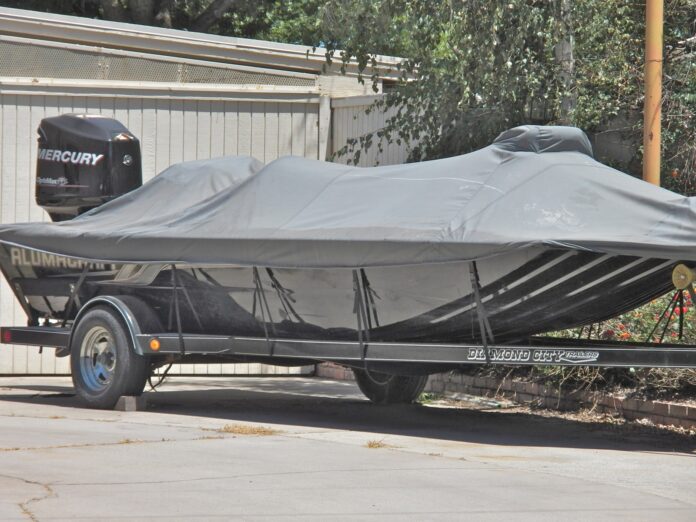By John Christopher Fine
Did you ever break down on I-95? Towing your boat? Even a flat tire is perilous where posted speed limits are only suggestions.
I’ve trailered and decided an extra 855 miles on I-95 was well worth saving money and wear-and-tear on the boat and trailer. If you’ve trailered your boat down to Florida from the north, you’ll know the feeling. It is a long, arduous trek with nothing in mind except getting there safely, hoping nothing goes amiss or breaks down.
I had a bearing go out in North Carolina. It was a weekend. I managed to get off I-95 without a tow. Shops were closed. A garage was open but the mechanic could not get to it until Monday when he could get parts. I found a motel we could walk to near the garage. We had our dog, the place was not too bad and they allowed the dog. Meals, room cost, wait until Monday. It could have been worse.
This time we lucked out since it was hospitable North Carolina and the mechanic was skilled. Costly, but skilled. Three days later we continued south to Florida, boat in tow. Imagine the cost if a trailer breaks down and the boat has to be removed from it on I-95, unthinkable and dangerous. Then what do you do? Buy another trailer or try to find a marine repair somewhere wherever the breakdown occurs?
I found Amtrak’s Auto Train. They take vehicles, trucks, trailers and boats. Size is important. Amtrak operates the Auto Train from Lorton, Virginia south to Sanford, Florida and the reverse every day. Trains leave late afternoon and arrive early morning. Accommodations aboard range from coach seats with reclining lounge-chair-like seats to small rooms with beds and showers. Continental breakfasts are included in all classes of service. Full dinners served in dining cars in sleeper class with wine at table, flowers, linen cloth and good food.
Here’s the catch: the maximum height on Auto Train is 85 inches, maximum width 84 inches, no dual wheel, gull wing or scissor doors. Vehicles are charged by size with standard up to 182 inches long running $225 to $285 and oversize up to 216 inches long from $255 to $325. Price is determined by date of travel. A boat trailer can be 18 feet long as long as it is not more than 85 inches high nor wider than 84 inches. From my experience, Auto Train is not only well worth it, it is the best way to get vehicles and trailered boats south in winter and north in spring. It is safe, convenient, easy and cost efficient. The wear and tear on equipment is a big saving over the long run.
A veteran boat transporter put things in perspective when he said he charged $4,200 to transport a boat on its trailer from Florida to New York. Why is it so expensive? The law’s the law. Simple as that. This boat transporter, who does not want to have his name used, said anything wider than 8.6 feet needs permits. Permits are required for different states. Can individuals tow their boats legally without permits? The transporter said authorities are cracking down due to increased accidents and, technically, permits are needed even by private persons.
The catch is that each state has different rules. And departments of transportation have rules that change frequently. In Tennessee, for example, a wide load requires a CDL permit to drive it. Anything over 25,999 pounds requires a CDL. Wide loads can operate only half-hour before and after sunset-sunrise. Beside high fuel costs, something I well know every time I push the “tow” lever on my truck, there are tolls. Trailering the George Washington Bridge is $110, $65 on the New York Thruway, $35 on the Delaware Memorial Bridge. All this varies, these quotes are ones the transporter gave me as examples. It is clear that towing a boat is expensive.
Auto Train charges boats and trailers as one other vehicle. Pull into the station with reservations, a loader takes the vehicle and trailer into special auto carriers, passengers take what is needed aboard double-decker cars with bar service lounges and free Wi-Fi, then enjoy a comfortable overnight ride that takes about 17-and-a-half hours.
Upon arrival vehicles are offloaded. Handlers even use plastic sheets so as not to dirty seats — quite efficient. For those in a hurry to get away, a $75 fee is charged for priority loading so the vehicle comes off first. Something I find unnecessary since I’ve only had to wait a half-hour to 40 to get my vehicle. Restrooms and coffee shops are available at Lorton and Sanford stations.
The Amtrak Auto Train works for me. I always have a vehicle chock-a-block full of dive gear and equipment. Vans, pick-ups and trailers are accommodated in Amtrak’s auto carriers that are enclosed to protect them. I don’t think fuel is likely to get cheaper anytime soon. Saving fuel costs — let alone motels — makes Auto Train practical. Amtrak Auto Train has a special telephone 877-skip-I95, appropriate enough 877-754-7495 if you want to check it out. Safe boating.

























